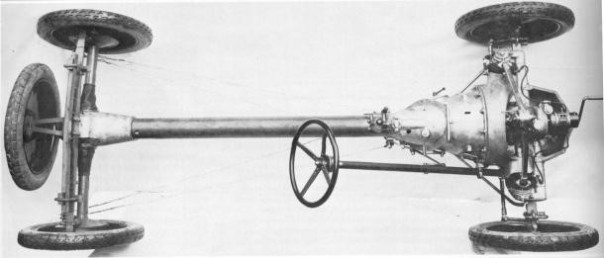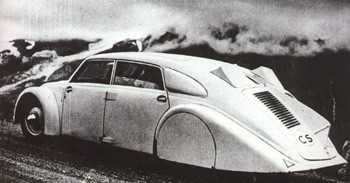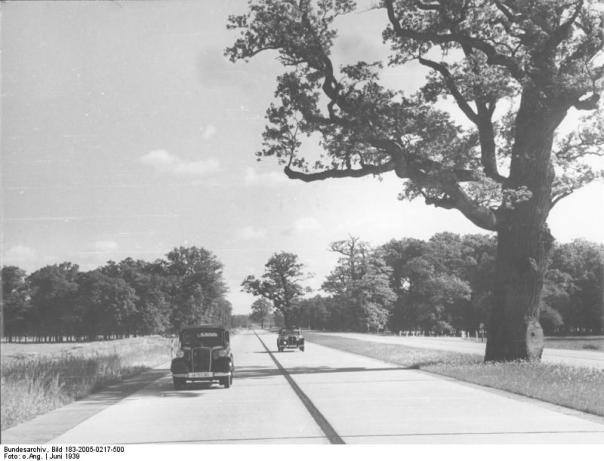Hans Ledwinka (1878-1967) sought to create a rational automobile, with form determined by function and available technology. He was by no means alone in this quest: Porsche, Rumpler, Ganz and even the directors of Daimler-Benz worked on parallel lines. In the larger context, the search for a rational automobile can be seen as an extension of the architectural theories of Walter Gropius, the Bauhaus movement, and Le Corbusier, the ex-factory manager who considered houses “machines for living in.”
Ledwinka, born near Vienna, passed nearly all of his working life at the giant factory complex in Koprivnice, Czechoslovakia, known since 1923 as Tatra (after the mountain range). Upon serving a brief apprenticeship, Ledwinka was put in charge of the fledgling automobile department. He rose to become a member of the board of directors and exercised direct responsibility over the entire complex, which, in addition to passenger cars, produced trucks, railway rolling stock, and locomotives. While Baron Ringhoffer was the owner of record, Ledwinka appears to have made the decisions.

Tubular Frames and Swing Arms
Ledwinka’s signature car, the car that set the pattern for subsequent models, was the Type 11 of 1923. It was the first commercially successful application of the central tube frame, which gave far better torsional and bending rigidity than the ladder frames then in vogue. As Ledwinka applied the principle, all forces – engine torque reaction, rear-wheel braking and acceleration, and steering inputs — were taken out through the tube. The body work merely had to support its own weight and the weight of the passengers.
The mass of the engine, coupled by the tube to the rear axle assembly, gave passengers fore and aft protection on the model of the heavy beams used under American Pullman cars. No provision was made for protection against side intrusions.
Large wheels, high ground clearance and a supple suspension with little or no overhanging bodywork were intended to cope with Czech roads, then among the worst in Europe. Styling was a function of design. The Type 11 looked like itself.
The swing rear axle must be counted as one of the most geometrically clever innovations in the history of the automobile, and among the most enduring. The concept was first documented by Edmund Rumpler’s 1903 German patent (see the Tropenwagen post). The swing axles mount in split housings that are hinged to pivot around the driveshaft centerline. Each axle terminates in a crown gear on its inboard end. A pair of pinions, concentric with the driveshaft, engage the crown gears. Thus, the crown gears and pinions remain in mesh as the wheels rise and fall in response to road irregularities.
The Type 11 and subsequent Type 12 models, with their understressed engines and short load paths were among the most durable automobiles ever built. Julius Mackerle, who succeeded Ledwinka as chief designer at Tatra, reports that some Type 11s were still in service in the 1970s, a half-century after their introduction.
The tubular chassis, swing-axle concept has been a feature of Tatra trucks since 1923.
In passing it can be noted that, in 1897, Ledwinka had assisted Rumpler in reverse-engineering a Benz car that would be eventually produced by the Tatra parent company. Both were quite young, in their early twenties, and recent graduates of Vienna technical schools.
Modular Construction and Air Cooling
In 1933 the company began producing air-cooled diesel engines that employed standard cylinders and built-up crankshafts, which simplified tooling and inventory. After the war, an upgraded version of diesel was available in 1, 2,4, 6, 8 and 12-cylinder configurations.
The built-up, Hirsch-style crankshaft permitted the use of roller-bearing mains with their outer races pressed into circular crankcase webs. Early Offenhausers had their babbit main bearings supported in the same, take-no-prisoners fashion.
By eliminating water jackets, pumps, hoses and radiators, air cooling cuts service requirements by 20%, according to Mackerle. Such failures, like those associated with the oiling system, are potentially catastrophic. The rapid warm-up times characteristic of air-cooled engines reduces cylinder wear during cold starts. The hard exterior these engines present is especially beneficial for off-road and military vehicles.
But as Ledwinka well knew, the problem with air-cooled engines is noise radiated by the cooling fins. Nor did it help matters that the higher mean cylinder temperatures associated with air cooling meant that pistons had to be set up loosely in their bores. Noise did not count for much with trucks, but the upscale automobile was becoming a portable environment, enclosed and isolated from the mechanical realities that underlay it. Ledwinka responded with the Type 77.
Aerodynamic Styling and Autobahnen
The Type 77 caused a sensation at the 1934 Berlin Auto Show. Hitler, recently installed as Chancellor, stopped by to chat with the designer and, eager to learn more, invited him to his hotel that evening.

Hanging the 3.4-liter V-8 engine behind the rear wheels minimized noise, at the expense of induced oversteer. A luggage compartment, built over the transaxle and accessible from the back seat, provided further insulation. Rear vision verged on nonexistent.
Suspension was independent on all four wheels, with swing axles at the back. The frame consisted of a U-tube, open on the underside, and with a reinforced floor pan welded to it. The tube also functioned as a tray for brake, fuel and oil-cooler lines, and gear-shift rods. Porsche would use a similar arrangement under the Volkswagen. (In a patent suit settled in 1961, VW awarded Baron Ringhoffer’s heirs for, it is said, three million marks.)
What attracted thousands of show-goers that winter in 1934 was the aerodynamic look of the car, with its elongated tail, vertical stabilizing fin and aggressive air intakes. It was a taste of the future.
Edmund Rumpler, Ledwinka’s supervisor back at the turn of the century when a Benz high-wheeled horseless carriage was state of the art, had gone on to become one of Germany’s leading aircraft builders. After the war the Versailles treaty from the skies, and Rumpler applied his skills to automobile design. His Tropfenwagen (loosely translated as “tear drop car”) was the first seriously aerodynamic automobile to achieve production. Perhaps a hundred examples were built during the early 1920s. Several of these vehicles, symbolizing the tyranny of the machine, were put to the torch in the final scenes of Fritz Lang’s movie Metropolis.
The Tropfenwagen indicated the direction, but the most important influence on the shape of the Type 77 was the work of Paul Jaray, a former Zeppelin designer. Jaray’s formula for the aerodynamic automobile was a blunt, rounded nose and a long tapering tail that would encourage laminar flow. The logical place for the engine would be in the rear.
What gave the Tatra immediacy was the law of June 23, 1933, which initiated the construction of the network of German superhighways, the autobahnen. As one enthusiast put it:
“Seven thousand kilometers of national highway are to be built, for no other purpose than to serve motor-vehicular traffic. They are to be entirely free of intersections, free of danger, without oncoming traffic – colossal traffic arteries that extend through the entire country…allowing traffic to proceed at speeds no one ever dared hope for.”

Work began immediately with Hitler, jackboots and all, shoveling away. All radios carried his message, “Begin! German workers to the job!”
What was missing was a suitable automobile. The Type 77 pointed the way, its foreign origin notwithstanding.
Approximately 1000 of the sexy, overweight, over-priced, and over-steering cars were sold. Subsequently, Tatra dropped the 77 in favor of the much-improved Type 87 that received the ultimate endorsement from Dr. Todt, the Third Reich construction czar. “This 87 is the autobahn car.” The Type 87 remained in production during the occupation of Czechoslovakia, alongside of trucks for the German army. It is said that most of the cars were shipped to Berlin for use by the SS hierarchy.
Rumpler, whose independent rear suspension and Tropfenwagen anticipated so much that Ledwinka achieved, was jailed in 1933 as a Jew. Goering and the Reichs Air Ministry chief Udets intervened. Rumpler was released and died in obscurity in 1940. Police immediately went to his Berlin apartment and threw the engineer’s records into the trash.
Ledwinka spent the war years overseeing Tatra production and, in 1942, was named an honorary director of the Technical Museum of Vienna. One of his projects was a propeller-driven and tracked snowmobile for the Eastern Front.

In 1946 the Communists nationalized the Tatra works. Baron Ringhoffer was convicted of collaboration with the Nazis and died in prison. Ledwinka was found guilty of the same charge and served six years. Upon his release, he was invited to resume his duties at Tatra. Understandably, the old man refused. “Now you say that. Six years ago you should have offered.” He took up residence in Munich, where he could be close to his son Erich, then chief engineer for Steyr-Daimler-Puch. The last of the automotive pioneers died on March 2nd, 1967, shortly after his eighty-ninth birthday.
I once owned a 1950 Tatraplan (a scaled-down 87, not much larger than a Volkswagen). It was a beautiful machine.